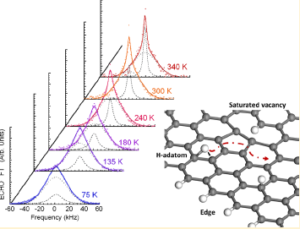 Bulk defective graphene produced by thermal exfoliation of graphite oxide was treated under H2 and investigated with X-ray photoemission spectroscopy, neutron spectroscopy, and solid state nuclear magnetic resonance. Graphene defects appear effective in dissociating H2 molecule and in promoting H covalent absorption on the carbon backbone. Measured generalized phonon density of states shows the presence of localized peaks ascribed to C−H bending modes already in pristine graphene, whose intensities
Bulk defective graphene produced by thermal exfoliation of graphite oxide was treated under H2 and investigated with X-ray photoemission spectroscopy, neutron spectroscopy, and solid state nuclear magnetic resonance. Graphene defects appear effective in dissociating H2 molecule and in promoting H covalent absorption on the carbon backbone. Measured generalized phonon density of states shows the presence of localized peaks ascribed to C−H bending modes already in pristine graphene, whose intensities
enhance when samples are treated under H2 at 1273 K. However, 1H NMR evidences a thermally activated dynamics with a correlation time of a few microseconds assigned to a part of H atoms bound onto the graphene plane. These findings point toward a diffusive dynamics of the hydrogen chemically bound to graphene sheets, already active at room temperature.
Reproduced with permission. Copyright 2014, American Chemical Society
